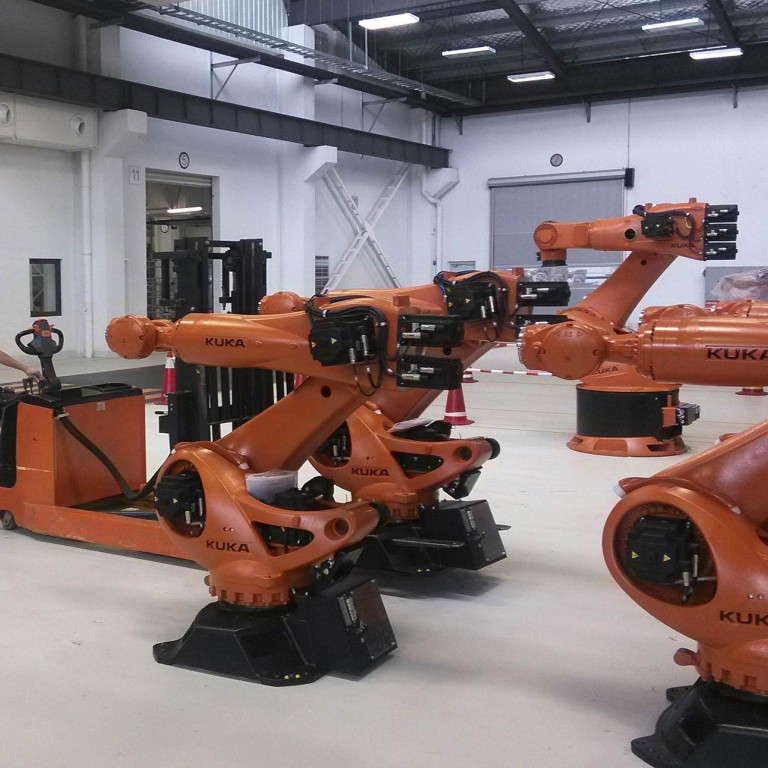
Chinese firms seek greater share of industrial robots market
New government policies and rising automation prompt mainland makers of the devices to step up production to garner a bigger slice of the market
Mainland suppliers look poised to increase their share of the fast-growing domestic market for industrial robots, benefiting from new government policies and rising automation in the manufacturing industry.
Last year, the country overtook Japan to become the world's biggest market for industrial robots as sales of such devices reached 36,560 units, of which 9,000 were bought from domestic suppliers, according to data from the International Federation of Robotics.
That could soon change as more sophisticated industrial robots are produced in the domestic market.
Qu Daokui, a deputy director of the State Engineering Research Centre for Robotics, said last month more than 30 robot-manufacturing plants were under construction on the mainland.
A report by Jefferies estimated the mainland bought one in five of all industrial robots sold last year, based on 179,000 units acquired globally.
Yukihiro Kumagai, a Jefferies equity analyst and author of the report, said "mainland [robot] manufacturers are not yet direct competitors to larger Japanese and European suppliers, but local firms appear to see rapidly growing sales in simple, task-handling robots".
While the carmaking sector is the largest and most lucrative field for industrial robots on the mainland and in the rest of the world, mainland companies are supplying low-cost robots used mostly in the electrical and electronics manufacturing sectors.
In an overall global market worth US$29 billion last year, mainland suppliers had found it tough to compete "because of their lack of cutting-edge technology", Kumagai said.
The Jefferies report said 40 per cent of mainland-made industrial robots sold last year were so-called Cartesian types that moved in a straight line, rather than moving up and down, in and out, or back and forth.
About 25 per cent were of a type known as Scara, for selective compliance assembly robot arm. A Scara robot's arms are designed to pick up components from one location and move them to another.

"Though large in quantity, China has a low robot density with 23 units for every 10,000 workers, compared to the world average of 58 units," Qu said at a forum in Shanghai last week, Xinhua reported.
There were about 420 robot manufacturing enterprises on the mainland at the end of September, he said.
Kumagai said he expected the situation for domestic suppliers would change in light of efforts by the central government to further develop the nation's expertise in robotics.
Two-and-a-half years ago, the Ministry of Science and Technology issued a 12th Five-Year Development Plan of Intelligent Manufacturing Technology, which was drawn up to solve technical problems and help robot companies expand their annual production.
The government said it aimed to encourage growth of the domestic market for industrial robots to reach three trillion yuan (HK$3.8 trillion) by 2020.
Financial subsidies were also issued by the Ministry of Finance to select mainland robot manufacturers.
Among the leading mainland players are Siasun Robot & Automation, Harbin Boshi Automation Equipment, Anhui Efort Intelligent Equipment, Shanghai Triowin Automation Machinery, GSK Step Electric and Qifan Industrial Robots.
While Japanese suppliers, led by Fanuc and Yaskawa Electric, sell the most industrial robots on the mainland, Kumagai said there were growing concerns about new tariffs that could be imposed on them.
Japanese robot makers currently enjoy beneficial tariff rates on their exports to the mainland. Yaskawa, the first Japanese robot maker to enter the mainland market in the past decade, has teamed up with state-owned China Shougang International Trade & Engineering to shift some production and deepen its presence on the mainland.
Alberto Moel, a senior analyst at Bernstein Research, said in a report that "there is renewed interest from companies, governments, and investors on industrial automation amid increasing labour costs in the developing world and high unemployment rates in the developed world".
In contrast to the highly automated carmaking sector, the electronics industry - particularly, the final assembly segment - remained labour-intensive, Moel said.
Hon Hai Precision Industry, Apple's main manufacturing contractor, famously vowed in 2012 to deploy 1 million industrial robots the following year to speed up automation at all its plants worldwide. But the high cost and limited supply of industrial robots made that an unrealistic target.
The robotics federation predicted industrial robot sales on the mainland would continue to drive global demand over the next few years. Total sales on the mainland are forecast to hit 100,000 units by 2017, up from an estimated 50,000 this year.

